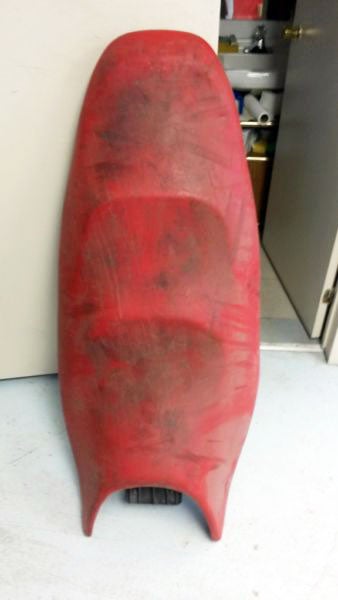Transform Your Aging PWC With An Aftermarket Seat Cover

Install an aftermarket seat cover with minimal fuss … and maximum results
Personal watercraft seat covers take a beating. The sun probably is the biggest culprit, shining down on them hour after hour, fading the colors, drying out the vinyl, and weakening the stitching. But its passengers, too, have an effect. Our weight stretches the material, and our carelessness results in the inevitable rips and tears.
After a while they show the effects and start looking worn and abused. And when they do, not only does the looks of the craft suffer, but so, too, does the rider’s comfort in the saddle.
Why not replace that cover and freshen things up? Here’s how to install an aftermarket seat cover with minimal fuss…and maximum results.
Step 1: Visit the seat store … and gather your tools
It’s no surprise that many of the same manufacturers that make traction mats also make seat covers. Check out the Blacktip line from Watercraft Superstore (watercraftsuperstore.net), HydroTurf (hydroturf.com), or longtime industry veterans JetTrim (jettrim.com). All offer seat covers for virtually every model ever made, and options to customize your colors and patterns. Go for the stock look, or create your own style. Some even offer grippier textures that will keep an aggressive rider firmly in the saddle. These manufacturers will produce a seat ready to fit your individual craft and get it to you quickly.
Perhaps the only truly “tricky” part of the job is gathering the appropriate tools. You may already have most of them — a flat blade screwdriver, needle nose pliers, and a heat gun or hair dryer. One you should invest in — or better yet, rent from a tool supply — is an electric, or possibly air-powered staple gun. Don’t try to do the job with a simple construction-style staple gun. It will take forever and the results will suffer.
 A pneumatic staple gun will make the job much easier to complete. Just remember to use stainless steel staples.
A pneumatic staple gun will make the job much easier to complete. Just remember to use stainless steel staples.Also make sure to purchase stainless-steel staples, so that rusting metal won’t ruin the looks of your new seat down the road.
Step 2: Prepare the old seat
You may be tempted to tear off the old vinyl, but many aftermarket covers are designed to simply slip right over the existing seat, in part to not disturb the waterproof covering over the foam below. Preparation, however, is key to a good result. Start by cleaning and drying the existing seat cover, and possibly repairing any tears with duct tape. Apply the latter smoothly, as you don’t want anything to affect the feel of the seat through the new cover.
Step 3: Bring on the heat
If possible, pick a nice sunny day, and start by laying your new seat cover out in the sun for a few hours. This will allow the material to stretch and conform to the seat contours without wrinkling. If you’re doing the job indoors, carefully substitute a hair dryer to achieve the same results.
Step 4: Find your center … then work the perimeter
Though your new cover will be shaped to fit your particular seat, you still need to take care to get it on correctly. Drape it over the seat first, and adjust it so that it lines up properly. Install your first staples at the front, underneath the seat lip, and directly in the center to keep things aligned. Next, do likewise at the corners. This will help keep the cover anchored in position.
 Aftermarket seats are available in a variety of materials.
Aftermarket seats are available in a variety of materials.With the key points of the cover secure, pull the material taut to eliminate any puckers and wrinkles and begin to work your way around the perimeter. Don’t go in one continuous line, but skip back and forth between sides, ensuring that the cover is laying properly and that any seams, patterns, color blockings, etc, are aligning as you want them to.
Don’t forget to remove the rear seat latch. Most seat covers are anchored below this latch, so get it out of the way, attach the cover, and then re-bolt the latch in place.
Step 5: Take care in the corners…and staple, staple, staple
Most difficulty comes in the corners, where excess material bunches and creates a problem. Take note of how the manufacturer handled the initial seat cover. Typically, corners are wrapped like you would a Christmas present to eliminate any bunching and keep the end result smooth and flat. Excess material in the way? Once you’re SURE you don’t need it, trim it carefully with a pair of sharp scissors.
Follow the manufacturer’s original pattern and use plenty of staples to anchor the new cover in place. This will keep things smooth and taut, and prevent wrinkles — or ever tears — down the road.
Step 6: Show it off
Now this should be self-explanatory. You’ve spent the time to make your craft look like new again. Get out and ride it!
Get PersonalWatercraft.com in your Inbox!
Like PersonalWatercraft.com on Facebook
Comments
Most Popular

2025 Yamaha JetBlaster PRO 2-Up Review

2024 Kawasaki Jet Ski STX 160X Review

Remembering the Sea-Doo XP

Whatever Happened to the Wetbike?

2025 Yamaha JetBlaster Review















 Your Privacy Choices
Your Privacy Choices